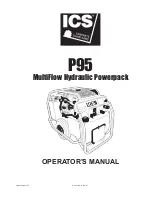
- 4 -
Maximal Expandable Power Systems
MaximalE Installation Instructions:
Wiring methods shall be in accordance with the National Electrical Code/NFPA 70/ANSI, and with all local
codes and authorities having jurisdiction . Product is intended for indoor use only .
1 . Mount unit in the desired location . Mark and predrill holes in the wall to line up with the top three keyholes
in the enclosure . Install three upper fasteners and screws in the wall with the screw heads protruding . Place
the enclosure’s upper keyholes over the three upper screws, level and secure . Mark the position of the lower
three holes . Remove the enclosure . Drill the lower holes and install the three fasteners . Place the enclosure’s
upper keyholes over the three upper screws . Install the three lower screws and make sure to tighten all
screws
(Enclosure Dimensions, pg. 12) .
2 . The power supply is pre-wired to the ground (chassis) . Connect main incoming ground to the provided green
grounding conductor lead . Connect unswitched AC power (115VAC, 60Hz) to the terminals marked [L, N]
on both power supply boards . Use 14 AWG or larger for all power connections . (Fig. 2, pg. 6) .
Green “AC” LED on power supply board will turn on .
This light can be seen through the LED lens on the door of the enclosure .
Keep power-limited wiring separate from non power-limited wiring.
Minimum 0.25” spacing must be provided.
CAUTION: Do not touch exposed metal parts.
Shut branch circuit power before installing or servicing equipment.
There are no user serviceable parts inside. Refer installation and servicing to qualified service personnel.
3 . Select desired DC output voltage by setting SW1 to the appropriate position, (Maximal11E, Maximal13E,
Maximal33E, Maximal35E and Maximal37E) (Fig. 1, pg. 5).
Maximal55E power supplies are factory set at 12VDC . Maximal77E power supplies are factory set at 24VDC .
Maximal75E power supplies are factory set at 12VDC and 24VDC (Power Supply Board Stand-by Battery
Specifications, pg. 5).
4 . Measure the output voltage of the unit before connecting any devices to ensure proper operation .
Improper or high voltage will damage these devices .
5 . Connect devices to be powered to the terminals marked [+ DC –] (Fig. 2, pg. 6) .
6 . For Access Control applications batteries are optional . When batteries are not used, a loss of AC will result
in the loss of output voltage . When the use of stand-by batteries is desired, they must be lead acid or gel type .
Connect battery to the terminals marked [+ BAT –] (Figs. 2-7, pgs. 6-11) .
Use two (2) 12VDC batteries connected in series for 24VDC operation (battery leads included) .
7 . Battery and AC Supervision outputs: It is required to connect supervisory trouble reporting devices to outputs
marked [AC FAIL, BAT FAIL] supervisory relay outputs marked [NC, C, NO] to appropriate visual
notification devices . Use 22 AWG to 18 AWG for AC Fail & Low/No Battery reporting (Fig. 2a, pg. 6) .
8 . Mount UL Listed tamper switch (not included) (Altronix model TS112 or equivalent) at the top of the
enclosure . Slide the tamper switch bracket onto the edge of the enclosure approximately 2” from the right
side
(Fig. 2b, pg. 6) .
Connect tamper switch wiring to the Access Control Panel input or the appropriate UL Listed reporting device .
To activate alarm signal open the door of the enclosure .
9 . Please ensure that the cover is secured with the provided key lock .
Maintenance:
Unit should be tested at least once a year for the proper operation as follows:
Output Voltage Test: Under normal load conditions the DC output voltage should be checked for proper
voltage level (Power Supply Stand-by Battery Specifications, pg. 5).
Battery Test:
Under normal load conditions check that the battery is fully charged, check specified
voltage at the battery terminals and at the board terminals marked [+ BAT –] to ensure
that there is no break in the battery connection wires .
Note: AL400ULXB2, AL600ULXB and AL1012ULXB (Power Supply Board) maximum charge current is 0 .7A .
AL1024ULXB2 (Power Supply Board) maximum charge current is 3 .6A .
Expected battery life is 5 years, however it is recommended to change batteries within 4 years or less if necessary .
Power Supply Board LED Diagnostics:
LED
Power Supply Status
Red (DC)
Green (AC)
ON
ON
Normal operating condition .
ON
OFF
Loss of AC . Stand-by battery is supplying power .
OFF
ON
No DC output . Short circuit or thermal overload condition .
OFF
OFF
No DC output . Loss of AC . Discharged battery .
Red (Bat)
Battery Status
ON
Normal operating condition .
OFF
Battery fail/low battery .






























